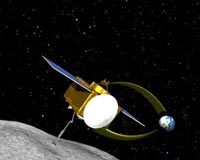 |
Washington (AFP) May 25, 2011 NASA on Wednesday said it plans to launch the first unmanned US spacecraft to a deep space asteroid in 2016 to collect samples and return them to Earth for further study. Last year, Japan became the first nation to complete such a mission when its Hayabusa probe brought back dust following a seven-year trip to an asteroid 300 million kilometres (186 million miles) from Earth -- about twice as far as the sun. The American mission aims to collect a larger sample from a closer target in the hopes that generations of scientists will be able to study it and learn about the building blocks of life in deep space, NASA scientists said. Whatever comes back in 2023 will be a "time capsule containing probably the building blocks of life," said lead investigator on the project, Michael Drake, director of the University of Arizona's Lunar and Planetary Laboratory. The spacecraft, known as Origins-Spectral Interpretation-Resource Identification-Security-Regolith Explorer, or OSIRIS-REx, will launch in 2016 and will then travel four years before it nears its target. The destination is a near Earth asteroid known as 1999 RQ36, which made headlines last year when scientists predicted it could strike Earth in the year 2182, a event classed at about a one-in-1,000 chance. The asteroid, described as "potentially hazardous" by NASA, passes within about 280,000 miles (450,000 kilometers) of Earth's orbit. After six months of surveying the terrain from a distance of three miles (five kilometers), NASA scientists will choose a spot, activate the craft's robotic arm, and pluck at least two ounces (60 grams) of material to return to Earth. Or it may grab as much as five pounds (two kilograms), depending on the density of the soil on the asteroid, which cannot be determined until the probe nears. The samples are scheduled to arrive in 2023. The total cost of the mission remains unknown since a launch vehicle has not yet been chosen, but will likely end up at over one billion dollars, NASA said. Lockheed Martin will be the principal builder of the spacecraft. "We will need a large launch vehicle for sure. This asteroid is a long ways away," said Jim Green, NASA planetary science division director. The launch would take place from Kennedy Space Center in Florida. Drake said the US mission aims to go beyond the Japanese probe. "The Japanese are to be congratulated for bringing home the probe with any kind of sample in it. It was a pretty uncontrolled event at the asteroid and they have almost no material to study," Drake said. "We however are being very careful and methodical in bringing back a well documented and adequate amount of sample to do the science on totally new material never before studied by humanity," he said. "To put it in perspective if you looked at the material brought back by the Hayabusa spacecraft and stuck it in a glass jar you would not be able to see it -- it's a dusty coating on the inside. It is a tiny amount in comparison." Asteroids can offer clues about the birth of the solar system because they formed from the cloud of gas and dust known as the solar nebula some 4.5 billion years ago. Some data can be gleaned from space debris that lands on Earth, though the samples are considered contaminated because they passed through Earth's atmosphere and came in contact with organic matter here. NASA administrator Charles Bolden described the effort as a "critical step in meeting the objectives outlined by President (Barack) Obama to extend our reach beyond low-Earth orbit and explore into deep space." "It's robotic missions like these that will pave the way for future human space missions to an asteroid and other deep space destinations."
Share This Article With Planet Earth
Related Links Asteroid and Comet Mission News, Science and Technology
 NASA to Launch New Science Mission to Asteroid in 2016
NASA to Launch New Science Mission to Asteroid in 2016Washington DC (SPX) May 26, 2011 NASA will launch a spacecraft to an asteroid in 2016 and use a robotic arm to pluck samples that could better explain our solar system's formation and how life began. The mission, called Origins-Spectral Interpretation-Resource Identification-Security-Regolith Explorer, or OSIRIS-REx, will be the first U.S. mission to carry samples from an asteroid back to Earth. "This is a critical step i ... read more |
|
| The content herein, unless otherwise known to be public domain, are Copyright 1995-2010 - SpaceDaily. AFP and UPI Wire Stories are copyright Agence France-Presse and United Press International. ESA Portal Reports are copyright European Space Agency. All NASA sourced material is public domain. Additional copyrights may apply in whole or part to other bona fide parties. Advertising does not imply endorsement,agreement or approval of any opinions, statements or information provided by SpaceDaily on any Web page published or hosted by SpaceDaily. Privacy Statement |